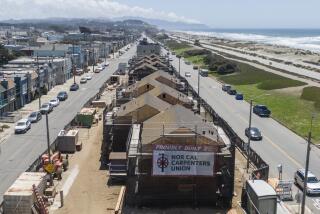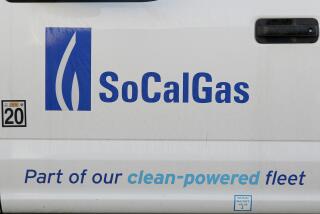Casting a cloud on home values
CHICAGO — This month, the Federal Energy Information Administration announced that winter heating bills are likely to jump by about 48% for Americans who use natural gas, with much of the increase brought on by the damage to natural gas production wrought by hurricanes Katrina and Rita.
Given Americans’ fondness for increasingly larger homes and for putting them in areas that require increasingly longer work commutes and more fill-ups at the gas pump, consumers may feel more of a blow than during previous energy-price spikes.
“It’s a double whammy of gas prices and heating costs,” said David Johnston, a Boulder, Colo., consultant on green building and energy conservation, adding that home values in outer suburban areas might be the first to be hurt by rising costs.
But in previous energy crises, consumers didn’t alter their housing preferences, according to Michael Carliner, an economist at the National Assn. of Home Builders in Washington, D.C.
“The ‘70s and ‘80s gave us a pretty good idea of what people say [about energy conservation] and what they actually do. They are different things,” Carliner said.
“They don’t tend to buy smaller houses or houses with lower ceilings or houses that are closer to work, to any significant extent. They tend to be more conscious of how efficient the equipment is in the house and how well-insulated it is. There will be increased attention to things like that,” Carliner said.
Builders and real estate agents agree that clients, in general, are more focused on closet space and countertops than on BTUs.
Beyond heating bills and home values, some costs may show up indirectly. Many home-building components, for example, are petroleum-based and are also affected by higher oil costs and the limitations on production and shipping brought on by the Gulf Coast storms.
Such building staples as vinyl siding, vinyl flooring, PVC pipe and roofing shingles are expected to take a hit.
Economists for mortgage financier Freddie Mac predicted earlier this month that construction-material costs (including non-petroleum-based items) are facing price increases. Hikes of 5% to 10% for materials could translate to a 2% to 3% increase in the cost of a home.
Further, high energy costs are feeding inflation worries that are expected to motivate the Federal Reserve Board to continue to raise short-term interest rates. Those rates have a coattail effect on longer-term mortgage rates -- widely regarded as the principal driver of the long-running housing boom.
The Mortgage Bankers Assn. in Washington doesn’t expect drastic changes in mortgage rates, however. Its current forecast is for 30-year rates, which have been rising incrementally for weeks, to average 6.6% in 2006 -- still low by historical standards.
“Our view would be that [higher energy costs] would have less to do with purchase activity than with people making mortgage payments on time,” said Doug Duncan, the trade group’s chief economist. “The last time we had a price spike in home heating fuels, we saw an increase in mortgage-payment delinquencies.
“Given a choice between making mortgage payments and keeping your house warm, people go with the warm house,” Duncan said.
More to Read
Inside the business of entertainment
The Wide Shot brings you news, analysis and insights on everything from streaming wars to production — and what it all means for the future.
You may occasionally receive promotional content from the Los Angeles Times.










